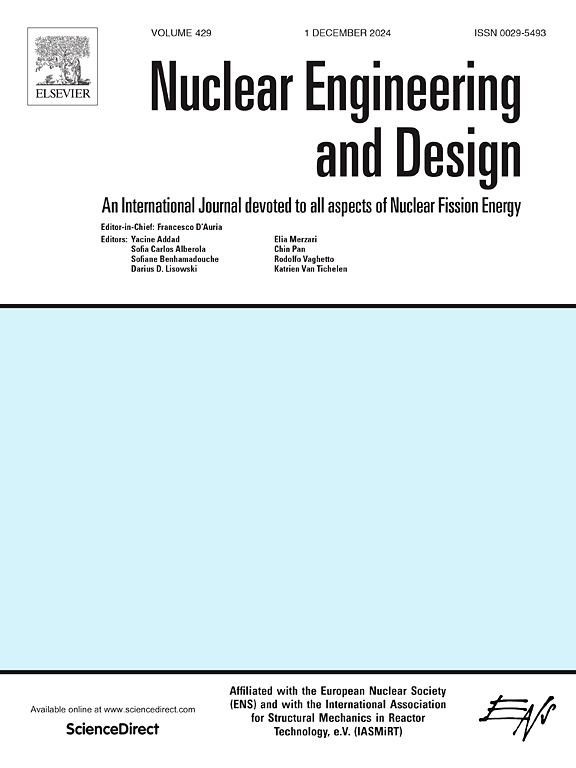Effects of magnesium chloride salts on stress corrosion cracking behavior of austenitic stainless steels used in dry storage canister
IF 1.9
3区 工程技术
Q1 NUCLEAR SCIENCE & TECHNOLOGY
引用次数: 0
Abstract
Austenitic stainless steels, including Types 304, 304L, and 316L stainless steel (SS), are commonly adopted canister materials for dry storage of spent nuclear fuels. When spent fuel storage installations are located near chloride-containing areas, stress corrosion cracking of austenitic stainless steels may take place as dried sea salts deposit on the stressed steel surfaces. The purpose of this study is to evaluate the corrosion behaviors of candidate canister materials with U-bend samples exposed to simulated chloride-containing environments. Various test environments were set up in a glass chamber with periodic spraying of magnesium chloride liquid solutions of three different concentrations at various temperatures and a controlled flow of vapor at a constant relative humidity of 40 % for 1500 h. Prior to the exposure tests, all samples underwent treatments of solution annealing and thermal sensitization.
After each specific test, surface morphologies and the presence of cracks on the samples were examined via scanning electron microscopy analyses. According to the test results in the presence of magnesium chloride deposits, except for the sensitized 304 SS and 304L SS samples, no cracks longer than 500 μm were observed in the sensitized 316L SS sample at 40 °C. The outcome indicated a better corrosion resistance of 316L SS than those of the other two at this designated temperature. At a higher temperature of 60 °C, 304 SS and 304L SS exhibited more cracks and pits than at 40 °C, and coalescence of pits dominated at an even higher temperature of 80 °C. On the other hand, 316L SS showed mainly pitting corrosion at 40 °C, but pits and cracks were observed at 60 °C. In particular, 316L SS exhibited more and deeper localized cracks originating from pits, while a smaller amount of overall corroded surface area was observed at 80 °C.
氯化镁盐对干储罐用奥氏体不锈钢应力腐蚀开裂行为的影响
奥氏体不锈钢,包括304型、304L型和316L型不锈钢(SS),是常用的干式储存乏核燃料罐材料。当乏燃料储存装置位于含氯化物区域附近时,由于干燥的海盐沉积在受应力的钢表面,奥氏体不锈钢可能发生应力腐蚀开裂。本研究的目的是评估u型弯管样品暴露于模拟含氯化物环境中的候选罐材料的腐蚀行为。在玻璃室内设置不同的测试环境,在不同温度下定期喷涂三种不同浓度的氯化镁液体溶液,并在恒定相对湿度为40%的控制蒸汽流下喷涂1500 h。在暴露测试之前,所有样品都进行了溶液退火和热敏化处理。在每次特定测试后,通过扫描电子显微镜分析检查样品的表面形貌和裂纹的存在。在存在氯化镁沉积的情况下,除敏化后的304 SS和304L SS试样外,敏化后的316L SS试样在40℃下均未观察到长度大于500 μm的裂纹。结果表明,在该温度下,316L SS的耐蚀性优于其他两种材料。在60℃的高温下,304 SS和304L SS的裂纹和凹坑比在40℃时更多,在80℃的高温下,凹坑的合并更为明显。另一方面,316L SS在40°C时主要表现为点蚀,而在60°C时则出现了凹坑和裂纹。特别是,316L不锈钢在80℃时,由于凹坑产生的局部裂纹更多、更深,而整体腐蚀面积更小。
本文章由计算机程序翻译,如有差异,请以英文原文为准。
求助全文
约1分钟内获得全文
求助全文
来源期刊

Nuclear Engineering and Design
工程技术-核科学技术
CiteScore
3.40
自引率
11.80%
发文量
377
审稿时长
5 months
期刊介绍:
Nuclear Engineering and Design covers the wide range of disciplines involved in the engineering, design, safety and construction of nuclear fission reactors. The Editors welcome papers both on applied and innovative aspects and developments in nuclear science and technology.
Fundamentals of Reactor Design include:
• Thermal-Hydraulics and Core Physics
• Safety Analysis, Risk Assessment (PSA)
• Structural and Mechanical Engineering
• Materials Science
• Fuel Behavior and Design
• Structural Plant Design
• Engineering of Reactor Components
• Experiments
Aspects beyond fundamentals of Reactor Design covered:
• Accident Mitigation Measures
• Reactor Control Systems
• Licensing Issues
• Safeguard Engineering
• Economy of Plants
• Reprocessing / Waste Disposal
• Applications of Nuclear Energy
• Maintenance
• Decommissioning
Papers on new reactor ideas and developments (Generation IV reactors) such as inherently safe modular HTRs, High Performance LWRs/HWRs and LMFBs/GFR will be considered; Actinide Burners, Accelerator Driven Systems, Energy Amplifiers and other special designs of power and research reactors and their applications are also encouraged.
 求助内容:
求助内容: 应助结果提醒方式:
应助结果提醒方式:


